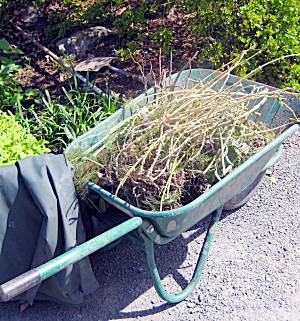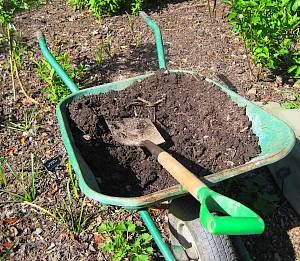Make Your Own Compost
Getting Started
Poor soil is a serious handicap for any gardener and one of the best ways to improve its structure is by incorporating compost. It will help sandy soils retain moisture and open up clay soils to improve drainage.
Plastic or wooden compost bins can be purchased quite cheaply or can be made even more cheaply from old timber. For most households, this is the ultimate example of recycling and helping our planet.
Anything that once lived will eventually rot down and could, therefore, be added to the compost heap. However, leftover animal meat tends to attract vermin and is best avoided. Larger woody material is also best avoided unless you have the means to chop it fine so that it can rot down at the same rate as other vegetation.
Locate your compost heap on soil so that worms, fungi and bacteria can easily get in to do their work. You also need to provide a cover for the heap to help keep it warm and to prevent excess rain getting in. Try to imagine the ideal conditions of temperature and moisture where you tend to find plenty worms and that is what you should aim to achieve.
You can study all kinds of theories about how to make the perfect compost, but appreciate that nature has been following essentially the same process for millennia, without any human intervention, so don't become obsessive about it.
Compost takes time to convert into a sweet smelling additive for your soil, so the sooner you start your compost heap the better.
Right Conditions
The important components for best results from your compost heap are nutrition, air and moisture. These are the essentials of life needed by the micro-organisms that do the hard work of converting waste products into valuable compost.
Nutrition
Those minute workers thrive on a balanced diet that contains carbon and nitrogen.
As a general rule, carbon is found in brown materials such as twigs, straw, hard stems, dried leaves and the like. You can also add clean cardboard and scrap paper though it is better if they are shredded to speed up the process of decomposition.
Nitrogen, on the other hand, is found in green plant materials such as fresh leaves, flowers, grass cuttings, weeds (though try to avoid perennials), uncooked vegetable waste from the kitchen, teabags, paper towels and similar.
See below for a more comprehensive list of ingredients for your compost heap.
Moisture
This is another essential for life and you should make an effort to keep the right balance.
If the heap becomes too wet, it may start to smell, in which case the best remedy is to add more brown materials.
The heap must not be too dry either, or you could be inviting other problems such as having a colony of ants move in. If too dry, you will also slow down the process of decomposition.
The obvious solution is to add more water. This is not an exact science, but the rule of thumb is the materials on your heap should appear damp but not soaking wet.
Air
This is the third essential ingredient, which means that you should avoid pressing materials down onto the heap. In fact, as the heap settles, you will probably need to introduce more air by stirring the heap up with a fork or other tool made specifically for this purpose.
If the heap becomes too compacted, the ultimate solution is to empty it all out of the container, turn it over and give it a good forking before returning it to the container.
Chop up materials

Whatever materials you add to your compost heap, they need to be chopped up, though not everything should be too fine. If you have a garden shredder, it is great for twigs and even small branches.
Alternatively, you can often do a good job with a small amount of materials by spreading it on a rough part of the lawn and running over it with a rotary mower. Take particular care with this method, however, that the mower is always under control and that hard materials are not thrown out like small missiles.
Knowing when compost is ready
Finished compost resembles thick dark soil, with a fresh, earthy smell. If you can still easily recognise any of the original materials, such as vegetable peelings, then you need to allow the compost more time.
Decomposition also depends on the temperature and therefore tends to be slower over the winter months than in summer. Under optimum conditions, the process may take around two months, but for most of us we may have to wait rather longer, perhaps up to six to nine months.
Using Compost

Homemade compost makes excellent mulch for your garden borders and vegetable patches. It may look a little lumpy with bits of twigs and other items still evident, though this does not detract in any way from its effectiveness.
However, if you are unhappy about the appearance, the answer is to fork it into the top inch or two of the soil and the worms will soon incorporate it in with the rest of the garden.
If you are potting up containers for your patio, you can mix the compost with ordinary garden soil (a ratio of around 3 to 1 should be suitable) to produce a healthy growing mixture.
You can use compost as a lawn feed, though appearance is particularly important in this case and you do not have the option of forking it in. For this purpose, you need to sieve out the bigger lumps, which can then be returned to the compost bin to be broken down further.
Warning
Although a very low risk in the UK, you should be aware of the possibility of contracting Legionella from compose
(see Garden Safety).
Ingredients for Compost
Green Materials
- Annual weeds
- Comfrey leaves
- Fruit peelings
- Grass cuttings
- Nettles
- Old bedding plants
- Old flowers
- Pond algae
- Rhubarb leaves
- Seaweed
- Tea bags, coffee grounds and filter papers
- Vegetable leaves such as cabbage or lettuce
- Vegetable peelings
Brown Materials
- Ashes from wood or paper
- Cereal boxes
- Corrugated cardboard packaging
- Crushed eggshells
- Dry leaves
- Egg boxes
- Feathers
- Garden prunings
- Hedge clippings
- Natural fibre clothing
- Newspapers
- Sawdust and wood chippings
- Shredded papers
- Straw
- Tissues and paper towels
- Toilet roll tubes
- Tumble dryer lint
- Wool
Read more about Types of Soil |
Read more about Soil and Climate |
